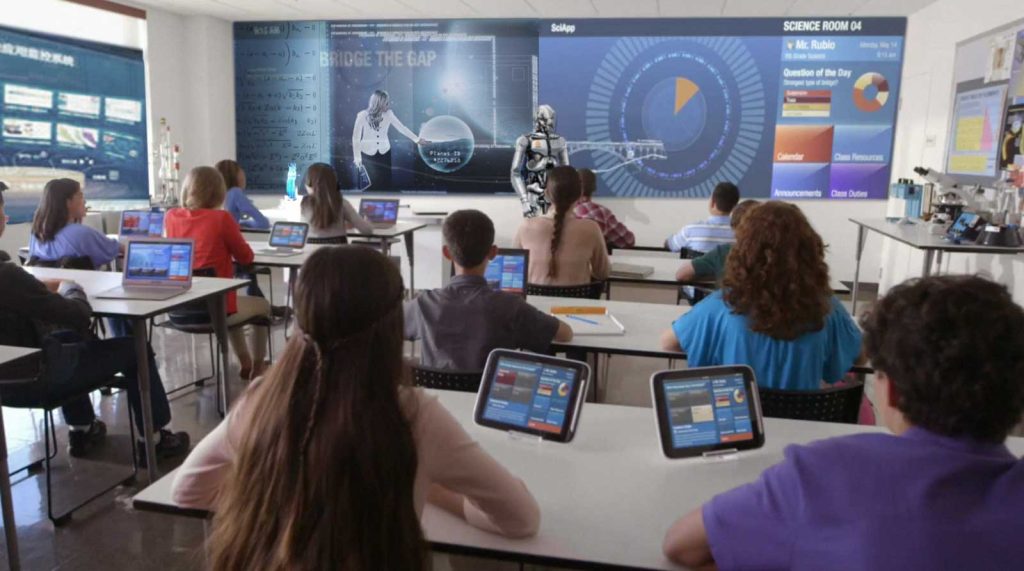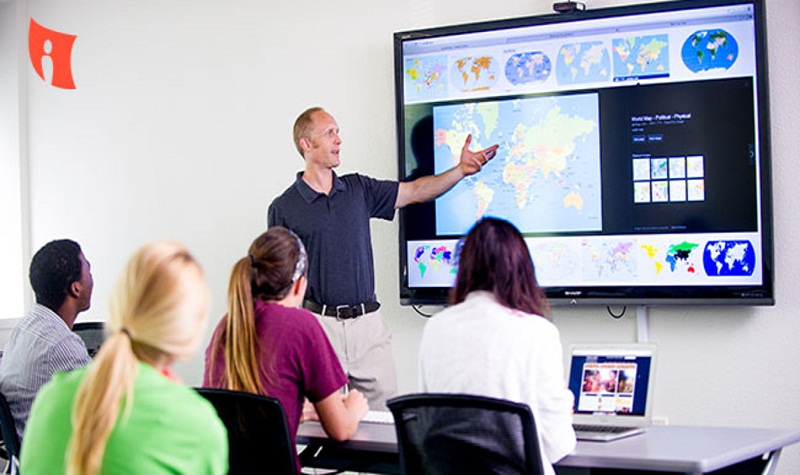Guide to the Best Digital Tools for Teaching English
- The Low-Tech Classroom: Maximizing Engagement with Minimal Technology
- Shared Document Collaboration
- Audio Recordings for Pronunciation Practice
- Online Writing Prompts
- Online Reading Platforms
- Quizzes and Assessment
- Exploring the Mid-Tech Landscape: Enhancing Learning with Basic Digital Tools
- Traditional Tools with a Digital Twist
- Incorporating Current Events and Digital Media
- Connecting through Forums
- The Tech-Supported Language Classroom: Embracing Innovation and New Opportunities
- Interactive Whiteboards
- Podcasts
- Storytelling Tools
- Online Quizzes and Surveys
- Gamification
- Digital Flashcards
- Multimedia Presentations
- Book Publisher Platforms
- Learning Management Systems (LMS)
- Looking to the Future
Learn more about our 21st Century Skills Methodology programmes and start dates.

In the ever-evolving landscape of education, embracing technology is crucial for engaging today’s learners and fostering a dynamic environment. For secondary and vocational English teachers in Europe, the integration of digital and online tools can greatly enhance classroom experiences and expand learning outcomes. This blog aims to guide educators through the best apps, online resources, and strategies for incorporating technology across various levels of tech accessibility. It’s a guide to the Best Digital Tools for Teaching English. We’ll explore applications for collaboration, project work, self-learning, assessment, lesson planning and course design. Learners come to Ireland with high levels of digital literacy and expect to use the same mediums for interaction and communication both inside and outside of the classroom. Select Ireland Schools operate in tech supported teaching environments, where classrooms have hi-speed internet access, interactive whiteboards, and access to a huge variety of online teaching resources. Teaching in Select Ireland School is supported by cutting edge technology to prepare students for real world use of English. This helps teachers to provide exciting and dynamic lessons, employing a variety of techniques and bringing the outside world into the language classroom. Teachers teaching English in secondary and vocational schools in Europe may have differing levels of technology available in their classrooms from nearly no-tech to fully tech supported, but there are many digital tools they can employ to engage their learners and expand their learning successes across these different landscapes.
The Low-Tech Classroom: Maximizing Engagement with Minimal Technology
In a low-tech classroom, minimal reliance is placed on advanced technological tools and devices for instructional purposes. In these classrooms, traditional teaching methods and non-digital resources take precedence, creating an environment where learning is primarily facilitated through analogue means. While some basic technology may be present, its use is limited, and the emphasis is on face-to-face interactions, tangible materials, and hands-on learning. Teachers in these classrooms can find keeping instruction materials up to date to be difficult and may find it difficult to engage their more tech-savvy learners who are accustomed to digitally based interaction. The following resources are not highly technologically advanced, but they can still complement traditional teaching methods in a low-tech ESL classroom, providing students with additional exposure to the English language.
Shared Document Collaboration
While traditional pen and paper may reign supreme in the low-tech classroom, teachers can still use basic technology for collaborative activities. Using tools like Google Docs or Microsoft Work to have learners co-write essays, brainstorm ideas or peer edit, fosters creative and critical thinking.
Audio Recordings for Pronunciation Practice
In a low-tech environment, audio recordings can serve as a valuable tool for improving pronunciation and speaking skills. Have students use their smartphones or other simple recording devices to practice reading passages aloud or engaging in scripted dialogues. By listening to their recordings and providing peer feedback, learners can enhance their language fluency and communicative ability.
Online Writing Prompts
Tap into online resources such as writing prompt generators or websites offering daily writing prompts. Share these with your learners during writing exercises and journaling sessions. While pen and paper are the primary tools, digital writing prompts inject creativity and variety into the writing process, sparking inspiration and encouraging self-expression.
Online Reading Platforms
Platforms like Project Gutenberg and Google Books provide access to a wide range of free digital books. Students can read these materials on their own devices or printed versions.
Quizzes and Assessment
Create quizzes using online tools like Google Forms or Quizlet and then print the questions for students. While the creation is digital, the distribution and completion are done through traditional means.
Exploring the Mid-Tech Landscape: Enhancing Learning with Basic Digital Tools
A mid-tech classroom is an educational setting that strikes a balance between traditional teaching methods and the integration of moderate levels of technology. In these classrooms, educators leverage a range of digital tools and devices to enhance instruction, foster student engagement, and provide a more interactive learning experience. While technology is integrated, it is used judiciously and purposefully to support specific learning objectives rather than completely replacing traditional methods.

Traditional Tools with a Digital Twist
While some educators may have limited access to technology (and some feel less comfortable using it!), there are still ways to infuse a touch of digital innovation into the classroom. Apps like Padlet and Flipgrid allow students to create virtual bulletin boards or record short videos, promoting collaboration and participation.
Incorporating Current Events and Digital Media
Online resource websites like ESL Brains and Lingua House provide up to date and topical lesson plans, utilising authentic audio and video clips to engage learners and bring the outside world into the classroom. Sites like breakingnewsenglish.com provide up to the minute lessons based on the latest news items.
Connecting through Forums
Establishing communication outside the classroom will ensure that learning doesn’t stop when the proverbial bell rings. Sites such as Edmodo and Google Classroom can be used to create online forums to continue discussions beyond the physical class setting and to provide frameworks for project-based learning.
The Tech-Supported Language Classroom: Embracing Innovation and New Opportunities
The Tech-Supported Language Classroom is an innovative and dynamic educational environment that integrates various technology tools to enhance language learning experiences. In this classroom setting, technology is strategically employed to augment traditional teaching methods, providing students with a more engaging, interactive, and personalized language acquisition journey. The integration of technology in language education aims to address diverse learning styles, promote collaboration, and prepare students for the communicative demands of the digital age. This is the environment in which all Select Ireland Schools provide lessons in. Our Guide to the Best Digital Tools for Teaching English.

Interactive Whiteboards
Classrooms equipped with technology such as interactive whiteboards and screens can elevate traditional teaching methods. Instead of dated and out of touch listening and reading materials, teachers can build dynamic lessons, utilising realia and other authentic materials focusing on real world and up to date topics. Teachers can link resources, manage homework and lessons, and build project ideas to provide engaging and interactive lessons.
Podcasts
Teachers can use tools like Audacity and GarageBand to create podcasts, allowing students to express themselves verbally and to practice language skills, while also working collaboratively and gaining supplementary skills.
Storytelling Tools
Use platforms like StoryJumper or Book Creator for digital storytelling projects where learners can create, collaborate, and share their own stories, reinforcing a variety of language skills.
Online Quizzes and Surveys
Platforms such as Kahoot can be utilised for interactive quizzes and surveys. These can be fun and topic based or they can review material covered in class so that teachers can quickly assess students’ understanding of the material and tailor lessons accordingly.
Gamification
Bring real-world language usage and popular culture into your classroom with apps and sites that engage learners and provide context for lexis. Apps and sites like Voscreen, Youglish and Lyricstraining challenge learners to understand real world grammar and lexis pulled from sources like Netflix, Ted-Talks, YouTube, and other media they often engage with daily.
Digital Flashcards
Use platforms like Quizlet to create digital flashcards with vocabulary words, idioms, or phrases to use in the classroom or for learners to use for self-paced review.
Multimedia Presentations
Enhance lessons with multimedia tools like Prezi, Google Slides or Adobe Spark. Engage students with dynamic and visually appealing content that supports language learning objectives. Save these lessons and build your own bank of bespoke lessons.
Book Publisher Platforms
Tap into digital resources provided by major book publishers. Platforms like Pearson eText and Oxford Learners Bookshelf offer a wide range of digital materials. Whether its e-books, supplementary exercises to consolidate input or interactive games for fun practice, these materials are aligned with curriculum standards such as the CEFR and put an increasingly familiar digital sheen on traditional textbooks.
Learning Management Systems (LMS)
Leverage the power of Learning Management Systems like Moodle or Canvas for comprehensive lesson planning and course design. These platforms facilitate content organisation, assignment distribution and communications.
Looking to the Future
As we continue to navigate the changing landscape of education, emerging technologies are poised to enrich language education further, offering new possibilities and enhanced learning experiences. Artificial Intelligence is at the forefront, providing personalised language learning platforms that adapt to individual student needs, offering tailored exercises and adaptive feedback. Augmented Reality (AR) goes one step further and brings language learning to life by creating immersive virtual learning environments. These technologies promise to transform language education, making it more accessible, personalised, and dynamic. Educators embracing these innovations will not only enhance the learning experience for their learners but will also equip them with the language skills necessary to think in an increasingly interconnected and technologically advanced world.
In Select Ireland Schools, we have found that integrating technology into the language classroom enhances the learning experience for both teachers and students. From the nearly-no-tech to fully tech supported classrooms, there are tools and resources tailored to various levels of technological accessibility. By integrating these digital tools into collaboration, project work, self-learning, assessment, lesson planning and course design, English teachers in secondary and vocational education across Europe can create a dynamic and engaging environment that prepares students for the complex communicative demands of the 21st Century.
Author: Director of Studies, Horner School of English, Dublin
